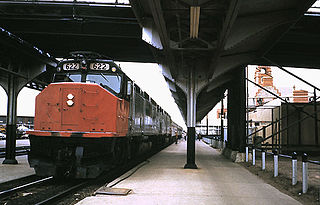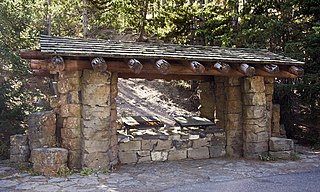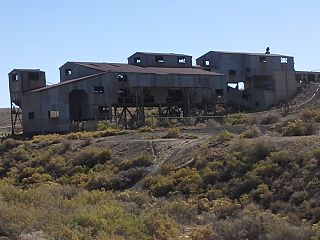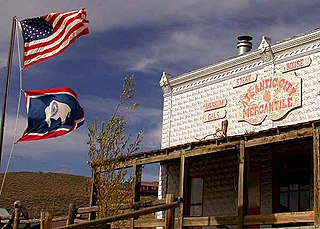
South Pass City is an unincorporated community in Fremont County, Wyoming, United States. It is located 2 miles (3 km) south of the intersection of highways 28 and 131. A former station on the Oregon Trail, it became a ghost town after later gold mines were closed. The entire community is listed on the National Register of Historic Places. The closest town is Atlantic City.

The Cheyenne Depot Museum is a railroad museum in Cheyenne, Wyoming, United States. It is located inside the 1880s Union Pacific Railroad depot. A National Historic Landmark, the station was the railroad's largest west of Council Bluffs, Iowa, and a major western example of Richardsonian Romanesque architecture.

The Obsidian Cliff Kiosk is a small structure that shelters an interpretive exhibit in Yellowstone National Park at Obsidian Cliff. The kiosk was built in 1931 as part of an effort to provide interpretive exhibits along the park's Grand Loop Road. In common with the Fishing Bridge Museum, Madison Museum and Norris Museum, the kiosk exemplifies the National Park Service Rustic style. The interpretive exhibit was designed by National Park Service's Carl Russell, who provided many other innovations in visitor experiences.

Mormon Row is a historic district in Teton County, Wyoming, United States that is listed on the National Register of Historic Places.

The Reliance Tipple is the site of two coal tipples associated with coal production at Reliance, Wyoming. The first tipple was built in 1910 and used until 1936. The wood structure was built on a sandstone foundation and served Reliance Mines No. 1 through No. 6. The perishable portions of the earlier tipple have disappeared, leaving only the sandstone foundations and some artifacts buried in the tailings pile.

The former U.S. Post Office-Green River is a Classical Revival architecture building designed by James Wetmore and Thomas Hyrum in Green River, Wyoming that was built in 1931. It was built under the Elliot Act, a pre-New Deal economic recovery plan. In 1967, the building was repurposed and is now Sweetwater County Historical Museum. It was listed on the National Register of Historic Places in 1997. Its 1997 listing included alternative name Trudel's Restaurante.

The ETD Bridge over Green River is a steel girder bridge near Fontenelle, Wyoming, which carries Sweetwater County Road CN4-8SS over the Green River. The bridge is a replacement for a historic Pratt through truss bridge built in 1913 by the Colorado Bridge and Construction Company. The 150-foot-long (46 m) bridge was one of the longest Pratt through truss bridges built in the early stages of Wyoming bridge construction.

The ETR Big Island Bridge is a Pratt through truss bridge located near Green River, Wyoming, which carries Sweetwater County Road CN4-4 across the Green River. The bridge was built from 1909 to 1910 by contractor Charles G. Sheely. It was named the Big Island Bridge after the Big Island region of Wyoming, which the bridge connected to other parts of the state. The 352-foot (107 m), two-span bridge is one of the older Pratt through truss bridges in Wyoming, and its spans, each 155 feet (47 m) long, are some of the longest on bridges of this design in the state.

The DMJ Pick Bridge is a Parker through truss bridge located near Saratoga, Wyoming, which carries Carbon County Road CN6-508 across the North Platte River. The bridge was built from 1909 to 1910 by contractor Charles G. Sheely; it was originally located south of Fort Steele. In 1934, the bridge was moved up the river to its current location, as a new bridge had been built at its original site five years earlier. The bridge is the only Parker truss bridge remaining in Wyoming, after the Arvada Bridge was replaced in 1990.

The DML Butler Bridge is a historic bridge over the North Platte River in Carbon County, Wyoming, United States, that is listed on the National Register of Historic Places (NRHP).

Fort Steele, also known as Fort Fred Steele, was established to protect the newly built Union Pacific Railroad from attacks by Native Americans during construction of the transcontinental railroad in the United States. The fort was built in 1868 where the railroad crossed the North Platte River in Carbon County, Wyoming. Work on the fort was carried out by military and civilian labor. Fort Steele was one of three forts built on the line. Fort Sanders near Laramie and Fort D.A. Russell at Cheyenne were the other railroad forts. Fort Steele was named for the recently deceased General Frederick Steele.

Atlantic City Mercantile is a former store now used as a bar and restaurant in Atlantic City, Wyoming. It is one of the chief buildings in the small mining town in the South Pass area of Wyoming, and is a significant example of a late 19th-century commercial building on what had recently been the frontier.

The Point of Rocks Stage Station is a former resting place at the meeting point of the Overland Trail and the Union Pacific Railroad in Sweetwater County, Wyoming, USA. It was built as a stop for the Overland Stage Line in the 1861 or 1862, equidistant between the earlier Black Buttes and Salt Wells stations, which were 28 miles (45 km) apart. The station served the stage line from 1862 to 1868. In 1868, the Union Pacific line reached Point of Rocks, putting the stage line out of business. The station then became a freight depot for nearby mines, with a road leading to Atlantic City and South Pass. The freight activity declined, and in 1877, the station became a residence. At one point it was allegedly inhabited by Jim McKee, a former member of the Hole in the Wall Gang. It became the property of the state of Wyoming in 1947 and is administered as Point of Rocks Stage Station State Historic Site.

Granger Station State Historic Site, also known as Granger Stage Station, South Bend Station and Ham's Fork Station, is a state park in Granger, Wyoming, United States, that is listed on the National Register of Historic Places (NRHP).

Rawlins station is a former train station in Rawlins, Wyoming. It was served by the Union Pacific Railroad from its 1901 construction to 1971, and Amtrak from 1971–1983 and 1991–1997. It was added to the National Register of Historic Places in 1993, as the Union Pacific Railroad Depot.

The Delfelder Schoolhouse, also known as Delfelder Hall, was built in 1920–21 on property formerly owned by Jacob Delfelder in Fremont County, Wyoming. The school was the third school building on the site, intended to serve the children of residents in the remote region of the county. The school operated until 1929, when transportation became available to allow students to attend school in Riverton. After its use as a school the building became a community center. In 1940 the Delfelder Hall Association was formed to purchase and operate the building, buying it for $575 and retiring the debt in 1943.

The American Legion Hall, Post 32 is a prominent social center in Greybull, Wyoming. Built in 1922 as a temporary church, it became an American Legion hall in 1935. Used as overflow space by nearby schools, it serves a diverse range of functions in the community.
The Laclede Station Ruin is a former way station on the Overland Trail in Sweetwater County, Wyoming, between the Big Pond Station and the Dug Springs Station. Constructed in the 1860s, the station was built of stone slabs. The ruins of some of its walls remain. The site was placed on the National Register of Historic Places on December 6, 1978.
The Dug Springs Station Site is a former way station on the Overland Trail in Sweetwater County, Wyoming. Constructed about 1862, the station was built with rock slab walls, between Laclede Station and Duck Lake Station. The site was placed on the National Register of Historic Places on December 6, 1978.
The Split Rock Archeological Site comprises a series of river terraces south of the Sweetwater River in Fremont County, Wyoming. The terraces have yielded Native American artifacts from the Early Plains Archaic Period. Several housepit features were found in 1984 excavations. The site was placed on the National Register of Historic Places on May 4, 1987.



















